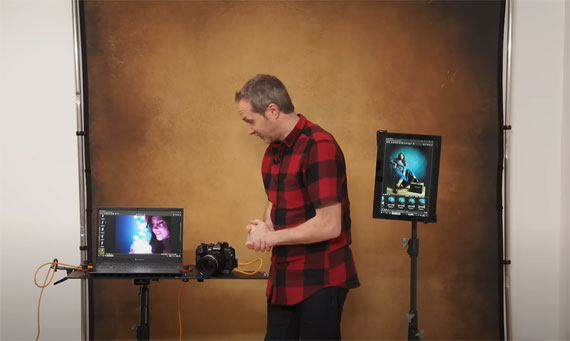Tethering is a method of connecting a camera to a computer or tablet in order to control the camera remotely and view the images on a larger screen. In this video, Gavin Hoey of AdoramaTV demonstrates the essentials of tethering and the pros and cons of using it during a photo shoot:
Gavin uses a USB 2 Tether Tools cable to connect his camera to a laptop running Windows 10 and Olympus OM System software. He also uses a tablet, in this case a Lenovo Mix, which he prefers for its portability and ability to rotate the screen. He emphasizes the importance of a sturdy tether table and a sandbag to keep the cable from tripping him over.
During the photo shoot, Gavin uses tethering to help him get the correct exposure and to fine-tune the lighting. He starts with a two-light setup and uses a shallow depth of field (F1.4 aperture) and high-speed sync flash. He notes that, because he can’t meter the light when using high-speed sync, it will be a trial-and-error session. He adjusts the power of the lights and angles until he is happy with the lighting on the model, Chloe.
Gavin also uses tethering to zoom in and check the catch lights in Chloe’s eyes and the highlights in her glasses. He also uses it to adjust the background light and ensure that it is not too bright.
Key Tips:
- Use a USB 2 Tether Tools cable for a reliable tethering experience.
- Use a sturdy tether table and a sandbag to keep the cable from tripping.
- Use a laptop or tablet running Windows 10 and Olympus OM System software for tethering.
- Use a tablet for its portability and ability to rotate the screen.
- Use a shallow depth of field (F1.4 aperture) and high-speed sync flash for a trial-and-error session
- Adjust the power of the lights and angles until happy with the lighting on the model
- Use tethering to zoom in and check the catch lights in the eyes of the model and the highlights
- Use tethering to adjust the background light and ensure that it is not too bright
- Use tethering to control the lighting, exposure, and composition
- Use tethering to prevent camera shake and create a more professional workflow
Overall, Gavin emphasizes the importance of tethering in controlling the lighting, exposure and composition of a photo shoot. He also mentions that it is helpful in preventing camera shake and in creating a more professional workflow.
Like This Article?
Don't Miss The Next One!
Join over 100,000 photographers of all experience levels who receive our free photography tips and articles to stay current:






